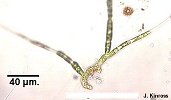FILAMENTOUS ALGAL SPECIES COMMON IN ACID AND SOFT WATERS.
Descriptions of operational taxa found in field studies in Scotland.
(Loch Ard
area of The Trossachs, Galloway, Islay, Morar and Glenelg:
Kinross, 1985, 1991 and unpublished data)
LIST
Chlorophyceae: Chaetophorales:Draparnaldia
Stigeoclonium
Chaetophora
Microthamnion
Taxon no. (1-50 as referred to in Kinross et al, 1993)
Chlorophyceae: Chaetophorales


This chaetophoracean has a main axis of cell approximately 50Ám. diameter with branches composed of narrower cells arising at intervals. These branches are subdivided to give a tufted appearance. The terminal cells are usually drawn out into a long colourless hair. The chloroplast is a parietal band, fimbriate in the large cells of the main axis. The filaments are enveloped in a mucilage layer giving a slippery feel, but the branches are not bound together by it.
20, 21, 51 = Stigeoclonium


This resembles Draparnaldia in the shape of the chloroplast and the possession of terminal hairs but shows no main axis differentiation and branching tends to be simple. There is no mucilage coat. There are numerous problems in the identification of Stigeoclonium species (Cox and Bold, 1966; Simons et al, 1986); for details look here.
For operational purposes when dealing with field material, three types have been recognized. The first has filaments composed of cells approximately 5-7-(8) Ám in diameter, the second has cells 8-14Ám and the third is upwards of 14Ám. broad.
53 = Chaetophora
This has tapering branched filaments like Stigeoclonium, but is enveloped in a dense mucilage. It forms a compact cushion-like colony and the individual filaments are difficult to separate out for examination (unlike Draparnaldia, for example)
34 = Microthamnion

This is a microscopic branched filament, with cells approximately 3Ám. in diameter, branching frequently but with short branches (only a few cells long), the terminal cells blunt with a single parietal chloroplast occupying approximately half the cell's circumference. The whole plant has not been found, in this study, to be more than 1 mm. in length. Its taxonomic relationships are uncertain but it is classified as a Chaetophoracean by Prescott (1970).
John
Kinross


